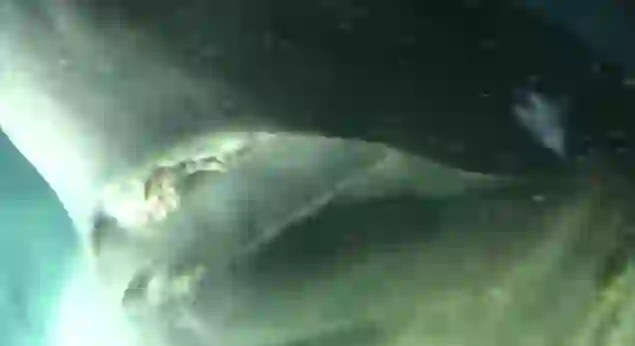A stunning deep-sea encounter has reignited curiosity about Earth’s most mysterious creatures. In newly resurfaced footage, an OceanX submarine comes face-to-face with a rare deep-sea creature—the bluntnose sixgill shark. This ancient predator has remained nearly unchanged for over 200 million years, surviving mass extinctions that wiped out the dinosaurs.
The massive shark appears from the shadows, drawn to the sub’s lights. It moves slowly, almost cautiously, as it circles the vessel. Despite its prehistoric origins, this species has managed to survive in the planet’s deepest, most uncharted waters. Unlike the well-documented great white, this shark rarely interacts with humans, making the footage even more remarkable.
The video, captured during a 2019 OceanX mission, highlights the challenges and excitement of deep-sea research. For years, scientists have struggled to study these creatures in their natural environment. Most research has relied on specimens caught by fishermen or temporarily brought to the surface. This encounter changed that, allowing scientists to attach a tracking device without removing the animal from its habitat. The breakthrough offers a rare window into the secretive life of a deep-sea predator.

A Shark from Another Era and a Groundbreaking Study
The bluntnose sixgill shark, or Hexanchus griseus, is one of the ocean’s oldest surviving predators. Unlike most sharks, which have five gill slits, this species has six, a feature dating back to some of the earliest known sharks. These giants can grow up to 20 feet long, making them one of the largest deep-sea sharks in existence. Despite their size, they remain elusive, preferring depths of over 6,000 feet. Their nocturnal habits and preference for the deep make them difficult to study.
OceanX, a team dedicated to deep-sea exploration, set out to change that. Led by Dr. Dean Grubbs of Florida State University, researchers aimed to track this rare deep-sea creature without disturbing its environment. Traditional shark tagging methods often require bringing the animal to the surface, which can cause stress and alter its behavior. Instead, the team developed a way to attach a satellite tag while the shark remained in its natural habitat.
The footage captures the moment the massive shark approaches the submarine, swimming cautiously but confidently. The researchers inside, well-prepared for the encounter, seize the rare opportunity. They successfully attach the tag, marking a milestone in deep-sea research. The technology allows scientists to track the shark’s movements without disrupting its natural behavior.

The Importance of Studying Rare Deep-Sea Creatures
Encounters like this are more than just breathtaking moments—they provide crucial insights into the health of marine ecosystems. Deep-sea sharks like the bluntnose sixgill play a vital role in maintaining balance by controlling fish populations. However, these ancient predators face increasing threats from commercial fishing and habitat destruction. Because they reproduce slowly, their populations are especially vulnerable.
By tracking this rare deep-sea creature, researchers gain valuable data about its migration patterns, feeding habits, and threats it faces. This knowledge can help conservationists develop strategies to protect not only sixgill sharks but also the entire deep-sea ecosystem.
Public interest in deep-sea exploration is also essential. The ocean remains one of Earth’s last unexplored frontiers, hiding species that have yet to be discovered. Advances in technology, like remote-operated submarines and satellite tracking, allow scientists to reach depths that were once impossible to study. Each encounter brings new discoveries that reshape our understanding of life on Earth.
A Future of Discovery and Conservation
This mission proved that deep-sea animals can be studied without removing them from their environment. Future research will build on this success, using similar techniques to tag and track other elusive species. As technology advances, scientists will be able to explore deeper and learn even more.
In the footage, the massive bluntnose sixgill shark approaches the OceanX submersible, its sheer size leaving the crew in awe. One researcher exclaims, “Oh, wow! Look at the width of that thing!” The shark’s curiosity is evident as it nudges the sub’s exterior, seemingly inspecting the humans inside. Another crew member describes the experience as “like coming face-to-face with a living fossil.” This behavior underscores the rarity and significance of such encounters, offering a glimpse into the seldom-seen world of deep-sea giants.
The video of the bluntnose sixgill shark reminds us of the ocean’s wonders. It also highlights the importance of protecting this rare deep-sea creature. By continuing to push the boundaries of deep-sea exploration, researchers can unlock secrets that may reshape our understanding of marine life, evolution, and even Earth’s past.

